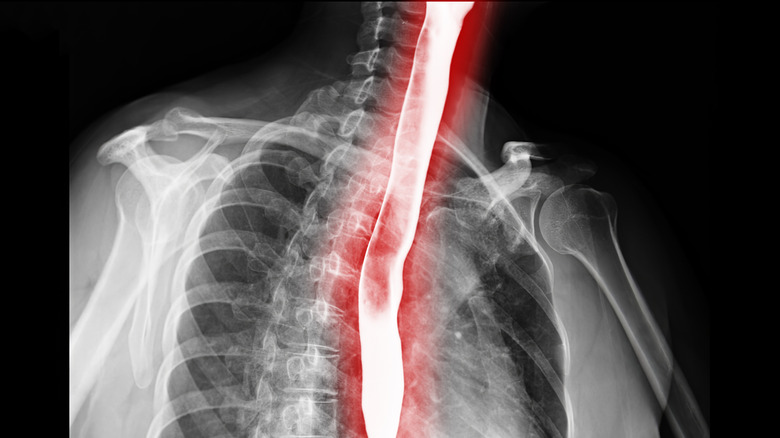Omeprazole Explained: Usage, Doses, And Side Effects
Omeprazole, which is prescribed under the brand names Prilosec and Prilosec OTC, is one of many medications known as proton pump inhibitors (PPIs) that work by preventing excessive production of stomach acid, per the Mayo Clinic. It is indicated for the treatment of gastroesophageal reflux disease (GERD), gastric and duodenal ulcers (peptic ulcers), and erosive esophagitis. The treatment of ulcers caused by H. pylori bacterial infection consists of omeprazole together with antibiotics such as amoxicillin and clarithromycin. Zollinger-Ellison syndrome, another disorder associated with overproduction of stomach acid, can also be treated with omeprazole.
According to Medical News Today, omeprazole can help heal acid-induced tissue damage in the stomach and esophagus. Recurring heartburn (occurring more than two times per week) can be treated with over-the-counter omeprazole, though it may take one to four days for complete relief. Omeprazole comes in the form of delayed release capsules, tablets, or granules for oral suspension. It is recommended to be taken 30 to 60 minutes prior to meals. Mild adverse effects of omeprazole include headaches, gas, nausea, and abdominal pain. Some people taking omeprazole may experience serious side effects such as kidney inflammation or severe diarrhea cause by infection with the bacterium Clostridium difficile.
How does omeprazole reduce stomach acid?
Omeprazole is not a "quick fix" for heartburn and other symptoms of acid reflux, per GoodRx Health. Unlike antacids such as Tums that provide immediate heartburn relief by neutralizing stomach acid, omeprazole works by a different mechanism that takes up to four days for full benefits. During the normal production of acid in the stomach, the final step in the process is mediated by an enzyme known as the proton pump (via Omeprazole). By binding to the proton pump, omeprazole, like other proton pump inhibitors (PPIs), shuts off the "pumping" of acid into the stomach, thereby reducing the total amount of stomach acid. Since pain relief is not immediate, antacids may be taken with omeprazole for faster action.
Omeprazole is most effective when taken at a time when acid production in the stomach is increased, i.e., before and during meals, notes GoodRx Health. Thus, it is preferable to take omeprazole 30 to 60 minutes before meals rather than at bedtime. Treatment of acid reflux symptoms with generic omeprazole or the equally effective brand-name Prilosec is typically limited to 4 to 8 weeks. Long-term use is not recommended due to increased risk of heart attacks and weakened bones. Omeprazole is considered safe for use in pregnancy.
Dosage forms of omeprazole
Omeprazole comes in delayed release capsules (10 mg, 20 mg, 40 mg), delayed release tablets (20 mg), delayed release granules (packets) to be mixed into water (10 mg, 2.5 mg), and oral (liquid) suspension (2mg/ml), notes Drugs.com. All forms of omeprazole are delayed release so that the drug is released into the intestine, thus bypassing destruction by acids in the stomach. Tablets and capsules should be swallowed whole with a full glass of water (via MedlinePlus). Tablets should not be split, chewed, or crushed. People who struggle with swallowing a capsule whole can empty the granules from the capsule into applesauce. The applesauce/granules mixture should be immediately consumed and not be kept for later use. The granule packets are mixed and stirred into a specific amount of water per instructions. After 2 to 3 minutes to allow the mixture to thicken, it is stirred again and consumed within 30 minutes. Any remaining medicine in the container should be mixed with more water, stirred, and consumed immediately. The liquid version of omeprazole, combined with sodium bicarbonate, was recently approved by the FDA to treat stomach ulcers and bleeding (per the Pharmacy Times).
Prescription omeprazole can be taken up to three times a day, depending on the condition being treated, according to MedlinePlus. It should be taken as directed per the prescription label. Prescription omeprazole should not be discontinued without a doctor's consent. Over-the-counter omeprazole is generally taken once a day in the morning before eating and for 14 consecutive days. A missed dose should be skipped, and the next dose should be taken per schedule. Avoid taking two doses at the same time.
Peptic ulcer disease
According to the Mayo Clinic, peptic ulcers are breaks in the tissue that lines the stomach (gastric ulcer) or the duodenum, the first part of the small intestine (duodenal ulcer). These open sores can also occur in both the stomach and the duodenum. Normally, a layer of mucous protects the inner lining of the stomach from corrosive digestive secretions such as acids and enzymes. However, an imbalance may occur whereby the protective mucous layer is depleted and the production of stomach acid is increased. This may result in damage and erosion to the walls of the stomach and duodenum and the formation of ulcers. In addition to infection with the bacterium Helicobacter pylori (H. pylori), another frequent cause of peptic ulcers is prolonged use of nonsteroidal anti-inflammatory drugs (NSAIDs) such as Advil, Motrin, and Aleve. The predominant symptom of peptic ulcer is burning pain in the stomach. Though many people are asymptomatic, others may experience nausea, bloating, belching, fullness, and intolerance to fatty foods.
Omeprazole and other PPIs are effective in decreasing the formation of ulcers and associated symptoms of indigestion, according to a 2013 study published in Arthritic Research & Therapy. By suppressing the secretion of stomach acid to prevent further tissue damage, omeprazole enables NSAID-induced ulcers to heal, even in people who continue to use NSAIDs.
Gastroesophageal reflux disease (GERD)
As reported by Harvard Health Publishing, gastroesophageal reflux disease (GERD) is a digestive disorder that occurs when the stomach contents back up, or reflux, into the esophagus. This "acid reflux" irritates and inflames the esophagus and typically results in sharp, burning pain in the chest known as heartburn. Ordinarily, a ring of muscles known as the esophageal sphincter acts as a valve to prevent food and acid from rising back up into the esophagus. In people with GERD, this valve does not close properly, and acid reflux ensues. Smoking, alcohol, specific foods, medications, and pregnancy are among the factors that can weaken or loosen the sphincter muscle. Apart from heartburn, people with GERD may also experience regurgitation of food, trouble swallowing, sore throat, hoarseness, coughing, wheezing, or nausea.
Together with lifestyle changes (e.g., weight loss and avoidance of tobacco, alcohol, and trigger foods), omeprazole and other PPIs are the cornerstone of treatment for GERD, per a 2018 review published in the journal Gut and Liver. Studies have established that PPIs such as omeprazole are superior to any other medical treatment in controlling the symptoms of GERD.
Erosive esophagitis
Erosive esophagitis (EE) is a severe complication of GERD that occurs when, over time, recurrent episodes of acid reflux cause ulcers in the lining of the esophagus (per the Merck Manual). Some people with this condition experience mild bleeding which, if prolonged, can lead to iron deficiency anemia. In others, bleeding may be so severe that they vomit blood and/or pass dark, bloody stools. Narrowing of the esophagus can also occur, causing a person to struggle swallowing solid foods. Recurrent reflux can cause abnormal cells lining the esophagus to become precancerous or even cancerous.
Complete healing of the esophagus and prevention of recurrence is vital for people with erosive esophagitis, per a 2022 review published in Expert Review of Gastroenterology and Hepatology. For example, cancer of the esophagus is life-threatening with poor survival rates. In the U.S., the customary treatment for erosive esophagitis is proton pump inhibitors (PPIs) such as omeprazole. Treatment of EE with PPIs is more effective when given for eight weeks versus four weeks. With a healing rate of 90.7%, omeprazole at a dose of 20 mg was superior to any other single-dose treatment.
Barrett's esophagus
Like erosive esophagitis, Barrett's esophagus is a serious complication of GERD, though it can occur in people who do not have GERD (via the Cleveland Clinic). Barrett's esophagus is characterized by an unexplained change in the tissue lining the esophagus whereby esophageal cells take on the appearance of cells that line the intestine. Estimated to occur in 1% of the population, Barrett's esophagus is not linked to any specific symptoms per se. Nevertheless, frequent heartburn and acid reflux as well as other symptoms of GERD may be warning signs of Barrett's esophagus. Precancerous cells, to some degree, along with an increased risk of developing esophageal adenocarcinoma, are associated with the condition. Fortunately, cancer of the esophagus is rare and does not occur in the vast majority (over 90%) of people with Barrett's esophagus.
Per a 2021 review published in Foregut: The Journal of the American Foregut Society, both animal and human studies suggest that reflux of the contents of the duodenum (first part of the small intestine) that include bile acids and pancreatic juice can cause DNA damage to cells in the esophagus and significantly contribute to the development of Barrett's carcinoma (cancer). Treatment with immediate release omeprazole at 40 mg twice daily was shown to control acid reflux occurring at nighttime in 100% of people with Barrett's esophagus. However, a higher dose of omeprazole at 80 mg per day may be more effective at reducing the risk of cancer of the esophagus.
Stress ulcer prophylaxis
Hospitalized patients who are critically ill or suffering from major trauma can suddenly develop stress ulcers, most often in the stomach, according to a 2022 review article published in The American Journal of Medicine. For the most part, rather than developing as a result of excess production of stomach acid, stress ulcers form when the protective mucous layer in the upper gastrointestinal tract is compromised. The protective mucosa that lines the stomach and intestine in patients who are critically ill is often defective. A major potential complication of stress ulcers is gastrointestinal bleeding, which can range from minimal to severe.
The use of omeprazole and other proton pump inhibitors (PPIs) is well-established as an acid-suppressive strategy to prevent stress ulcers, continues the review. However, PPIs are often overused in hospitals for stress ulcer prophylaxis. Though not usually warranted, patients are often discharged home on high dose PPIs, including omeprazole. Long-term use of PPIs is associated with serious complication such as fractures, Clostridium difficile infection, and chronic kidney disease. It is suggested that the use of PPIs for stress ulcer prophylaxis be restricted to high-risk patients who are critically ill.
Zollinger-Ellison syndrome
Zollinger-Ellison syndrome (ZES) is an uncommon disorder in which tumors, or gastrinomas, form in the duodenum or the pancreas (via the Mayo Clinic). The gastrinomas secrete an abnormally high amount of the acid-producing hormone gastrin (hence the name "gastrinoma"). High levels of gastrin lead to excessive production of stomach acid, which can potentially cause peptic ulcers in the stomach or duodenum. Other symptoms of Zollinger-Ellison syndrome include diarrhea; burning abdominal pain; acid reflux and heartburn; nausea and vomiting; weight loss; poor appetite; and intestinal bleeding. The gastrinomas are frequently cancerous and can spread to adjacent lymph nodes or the liver.
According to a 2013 review published in the journal Expert Opinion on Pharmacotherapy, omeprazole and other PPI drugs are the first line of treatment for excess acid production in people with Zollinger-Ellison syndrome. Studies have demonstrated that the acid-suppressing effects of PPIs persist for up to 10 years. Nevertheless, a major disadvantage of the use of PPIs is that they can delay the diagnosis of ZES and make it more challenging. Since omeprazole and other PPIs are long-acting, it's difficult to stop the medication in order to evaluate stomach acid secretion as part of the diagnosis of ZES. Moreover, the use of PPIs can cause high levels of gastrin in the blood, potentially leading to a false diagnosis of ZES. This occurs because the acid suppression from the PPIs triggers the body, via a feedback loop, to increase acid-producing gastrin to compensate for the low acid levels in the stomach.
H. pylori infection
H. pylori (or Heliobacter pylori) is a bacterium that colonizes the stomachs of roughly 35% of Americans and half of the global population, reports GoodRx Health. Infection with H. pylori increases the risk of stomach cancer. The bacterium is spread from person to person via contaminated food or water. Some people with H. pylori infection do not have symptoms and are unaware of the infection. Others experience stomach irritation or burning ulcers in the stomach or duodenum.
The treatment of choice for H. pylori infection is a triple therapy consisting of a PPI such as omeprazole plus two antibiotics. For example, a 14-day treatment plan may include twice daily doses of omeprazole (20 mg), amoxicillin (1,000 mg), and clarithromycin (500 mg). Since certain PPIs such as Nexium are more effective against H. pylori, omeprazole needs to be given at higher doses or more frequently to achieve similar outcomes. Because of increasing antibiotic resistance, another bacteria-killing drug — bismuth — may be added to the treatment regimen. An example of this quadruple therapy would consist of omeprazole, tetracycline, metronidazole, and bismuth subsalicylate (Pepto-Bismol).
Per a 2019 review published in World Journal of Gastroenterology, the role of the PPI in H. pylori therapy is to increase the pH (lower the acidity) of the stomach, thus making it less favorable for the growth of H. pylori. Moreover, H. pylori is more susceptible to antibiotics in a less acidic environment.
Mild adverse effects
Headache tops the list of common adverse effects of omeprazole, notes GoodRx Health. Headaches are usually mild and are more likely to occur within the first week of starting omeprazole. Another common mild side effect of omeprazole is abdominal pain occurring anywhere between the chest and the groin. If abdominal pain persists, it may be a sign of stomach polyps and should be medically evaluated. Some people on omeprazole become nauseous or even vomit. Since taking the medication with meals is not recommended, other ways to prevent nausea and vomiting include eating frequent smaller meals, eating bland foods, or avoiding lying down after meals. Nausea can be a sign of kidney problems requiring urgent care if symptoms such as extreme fatigue, swelling, or urination changes occur as well. Gas that causes bloating or cramps as well as mild diarrhea are also common in people on omeprazole. OTC medications for gas and diarrhea can be helpful.
Bone fractures — particularly in the hips, wrists, and spine — can result from long-term use of high doses of omeprazole. The risk of fractures can be minimized with lower doses and shorter treatment duration. Adequate intake of calcium and vitamin D is also important. Omeprazole may also increase the risk of respiratory infections caused by stomach bacteria migrating to the lungs. Since stomach acid acts as an antiseptic to prevent growth of germs, suppressing acid production with omeprazole makes a person more prone to bacterial infections.
Serious adverse effects
Though uncommon, long-term use of PPIs such as omeprazole may block the absorption of magnesium, resulting in low levels of magnesium in the blood, according to a 2015 study published in Gastroenterology Report. Low blood magnesium can cause a variety of adverse effects including convulsions, muscle cramps and spasms, dizziness, weakness, nausea, tremors, anxiety, hallucinations, loss of consciousness, and even life-threatening arrythmias. Vitamin B12 is another essential nutrient that is poorly absorbed in people on long-term omeprazole therapy, reports Medical News Today. Since vitamin B12 is important for the health of the nervous system, its deficiency can lead to nervousness, nerve inflammation, and numbness and tingling in the extremities.
The suppression of stomach acid production resulting from the use of omeprazole raises the risk of Clostridium difficile infection, which can cause severe diarrhea along with stomach pain and fever. Pain in the side or back can be a sign of kidney damage, continues Medical News Today. Omeprazole also increases the risk of both the cutaneous (skin) and systemic forms of lupus erythematosus. Cutaneous lupus is marked by skin rashes that may be red, purple, scaly, or raised. Systemic lupus can cause fever, weight loss, blood clots, or heartburn. A type of growth on the stomach lining known as a fundic gland polyp is another potential adverse effect of omeprazole.
Contraindications
Omeprazole is contraindicated if you are sensitive or allergic to the drug itself or to inactive ingredients in the dosage form, notes WebMD. Your physician should be aware of your medical history, particularly any reactions to similar drugs or a history of liver disease or lupus. Your physician should also be informed of all drugs (both prescription and nonprescription) and herbal supplements you are taking. A number of drugs interact with omeprazole, affecting its activity and the risk of adverse effects. For example, the acid-suppressing effects of omeprazole may impact the effectiveness of certain drugs that require stomach acid for efficient absorption into the body. Among these drugs are antifungals, antiviral drugs, and certain cancer medicines. Omeprazole also interacts with some cardiovascular-related drugs, the antibiotic rifampin, the chemotherapy drug methotrexate, and the herb St. John's wort. Some of these medications may increase the rate of metabolism of omeprazole by liver enzymes, thus reducing its concentration in the body (via Omeprazole).













